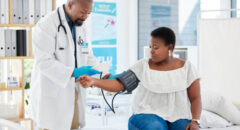
Breast health is not, and never has been, a one-size-fits-all prescription. The general principles are the same whether you’re in your 40s, 50s, or 60s, but how you apply them changes with time. That’s because options in your 30s are different from those you confront in your 40s or 50s.
Celebrate great health! LIKE BlackDoctor.org on Facebook!
Following is a decade-by-decade guide to your breast health.
Your Breasts in Your 30s
During this decade, hormones like estrogen help to keep breasts firm. Breasts contain no muscles. Rather, they consist of fibrous tissue, fatty tissue, plus dense glandular tissue that includes milk-producing glands called lobules and ducts to carry milk.
Fortunately, in the 30s, breast problems tend to be benign (noncancerous). Younger women commonly experience fibrocystic breast disease, a broad term that is characterized by breast pain, cysts, and noncancerous lumpiness. Fibroadenomas can also affect women in their 30s. These rubbery lumps made of fibrous and glandular tissue aren’t cancerous, but they can hurt. If they’re bothersome, they can be surgically removed.
During this decade, which has become more popular for childbearing, breastfeeding offers mothers some long-term protection against breast cancer. But some women worry that breastfeeding will cause breast sagging. Experts say that nursing doesn’t actually cause breast tissue to droop. Instead, breast swelling during lactation can stretch the skin over the breast.
Things that contribute to sagging include: larger pre-pregnancy bra cup size, greater number of pregnancies, cigarette smoking (which can weaken skin elasticity), and older age. As the years go by, breasts become less glandular and fattier, which makes them less firm.
You can’t do much to slow or prevent sagging. Because the breasts contain no muscles, you can’t really exercise your way to a perkier chest. However, some doctors advise women to wear sports bras during jogging to prevent bouncing that can stretch the ligaments. Breast cancer is uncommon; women aged 30-39 have a risk of only one in 229 of being diagnosed with breast cancer, according to the National Cancer Institute.
Unless there’s a strong family history of breast cancer, women in their 30s don’t need mammogram screening. In fact, younger women’s denser breast tissue makes it harder to detect breast cancers on mammograms.
However, regular manual breast exams by your doctor are crucial to check for lumps, skin dimpling, and other signs of breast cancer, according to experts.
Your Breasts in Your 40s
During the 40s, breast shape continues to change for most women. After menopause, the breast has less glandular tissue but more fat, leading to more sagging.
The Revlon/UCLA Breast Center reports that cysts are the most common type of breast lump seen in women during their 40s, although cysts can develop at other ages as well. These fluid-filled sacs aren’t cancerous, but they can be painful. Doctors can drain or surgically remove them.
Cellular changes like atypical ductal hyperplasia may also begin during this decade, Downey says. These abnormal cells in the milk ducts increase a woman’s chances of breast cancer.
The numbers show that breast cancer risk rises during this decade; a woman between the ages of 40 and 49 now has a one in 68 chance of being diagnosed. Therefore, mammogram screening enters the picture.
The medical community has debated the benefits of mammography for women in their 40s, in part because false positives can lead to unnecessary anxiety and procedures.
The National Cancer Institute recommends getting a first mammogram at age 40 and then one subsequently every one to two years afterward. However, women with a strong family history of breast or ovarian cancer should ask their doctors about starting mammogram screening before 40.
The National Cancer Institute also urges all women to report the following breast changes to their doctors:
- A lump in or near your breast or underarm
- Thick or firm tissue in or near your breast or underarm
- Nipple discharge or tenderness
- A nipple pulled back or inverted into the breast
- Itching or skin changes, such as redness, scales, dimples, or puckers
- A change in breast size or shape
But don’t worry about underwire bras, antiperspirants, or trauma to the breast increasing your risk, Steiner says. None of these has been proven to promote breast cancer.
Your Breasts in Your 50s
After menopause, the breasts not only become fattier but will shrink because women no longer need the milk-producing glands for breastfeeding.
While harmless lumps may come and go with the menstrual cycle in younger women, any new lump that appears after menopause requires a doctor’s prompt attention.
Most breast cancers occur in women over age 50, according to the National Cancer Institute. From ages 50 to 59, a woman’s chance of being diagnosed with breast cancer stands at 1 in 37.
In the 50s decade, experts advise women to get mammograms every year.
The good news? Doctors have an easier time detecting breast cancers in older women because breast density is less likely to obscure tumors. As the fat content increases, the sensitivity of the mammogram often increases.
It’s also smart to keep your weight under control. Research has shown that the chances of developing breast cancer after menopause are higher in overweight or obese women.








